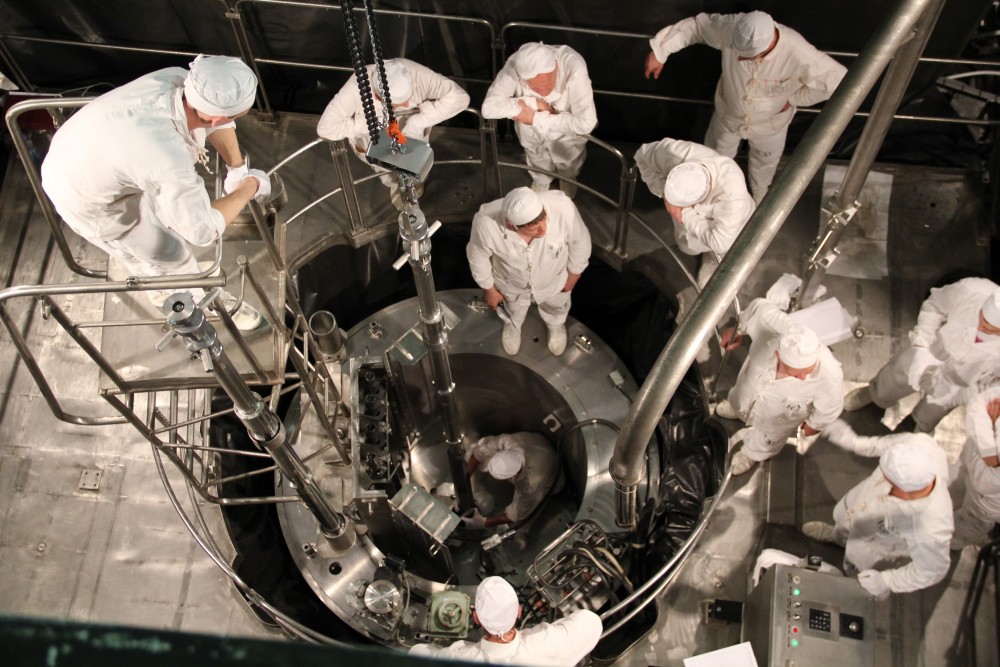The technical design bureau of Rosatom, Russia’s state nuclear corporation, has begun drawing up blueprints for a scaled-down version of its floating nuclear plant, the Akademik Lomonosov, with the aim of selling it to foreign customers, the Kommersant daily newspaper reported.
The technical design bureau of Rosatom, Russia’s state nuclear corporation, has begun drawing up blueprints for a scaled-down version of its floating nuclear plant, the Akademik Lomonosov, with the aim of selling it to foreign customers, the Kommersant daily newspaper reported.
The comments came in a wide-ranging interview late last month with Andrey Nikipelov, head of the Atomenergomash bureau, who said new designs for an optimized floating nuclear energy station should be complete withing the next two years.
The announcement follows last year’s reports in Strana Rosatom, Rosatom’s online corporate news portal, that Iceberg, another nuclear design bureau within the corporation, had sketched out plans for a floating plant for deployment in warm climates. Then, this past January, the portal published news that those plans would be revised to design a optimized floating plant that could be used in Arctic settings.
Nikepilov’s remarks to Kommersant offer fresh official comments from within Rosatom’s apparatus that those plans are inching toward fruition.
The Akademik Lomonosov, which was launched to the concern of environmental groups, has long been discussed by Rosatom as a commodity Moscow is anxious to replicate and sell abroad. But the plant’s several hundred million dollar price tag, coupled with a protracted construction effort that lasted more than a decade, has made the idea hard to sell.
Yet, ever since the Akademik Lomonosov and its two KLT-40S reactors left the Baltic Shipyard in 2019, Rosatom officials have touted the notion of developing a more streamlined version of the hulking nuclear barge for foreign buyers. Nikipelov’s statements last month, coupled with other recent reports in Russian media, offer a clearer picture of what that effort would look like.
In December, the semi-official RIA Novosti reported on the so-called “optimized floating nuclear plant,” the draft designs for which were unveiled by Atomenergomash, at an engineering conference in St Petersburg. Compared to the 140-meter-long Akademik Lomonosov, the optimized plant would be structurally simpler and easier to reproduce on mass scale, said Nikipelov.
It would also be more powerful, Nikipelov said, relying on two modernized RITM-200 reactors, the type that powers Russia’s new generation nuclear icebreakers, instead of the KLT-40. That would increase its output to 100 megawatts – a 30 megawatts increase on what is supplied by the Akademik Lomonosov.
Nikipelov added said the new design would solve a major flaw in the Akademik Lomonosov, which has long worried environmental organizations, including Bellona. Every 12 years, the Lomonosov has to be towed back to the port of Atomflot, the headquarters of Russia’s nuclear icebreaker fleet near Murmansk, to offload spent nuclear fuel.
The optimized design features a removable spent fuel storage module, allowing reactors to remain in place for refueling operations. It would also feature a spare RITM-200 reactor that could be switched in while others are down for refueling operations.
In terms of dimensions, Nikipelov told Kommersant that the optimized floating plant would be 25 percent shorter and narrower than the Akademik Lomonosov, and would required a smaller crew to operate it than the 70 that staff the older model.
In December, the official Tass newswire quoted Russian politicians as saying numerous foreign countries are interested in acquiring optimized floating nuclear plants. While it remains unclear precisely which countries those are, Rosatom has long claimed that unspecified governments in North Africa, the Middle East and Southeast Asia are interested in acquiring floating nuclear plants.
Tass also reported that Rosatom was in talks with Cuba about both land-based and floating reactors. The company also discussed the possibility of building a floating plant for Sudan in 2018.
Bellona has opposed Russia’s aspirations to build floating nuclear plants since the Akademik Lomonosov’ construction began in 2006, and has published a detailed catalogue of its concerns in a report it released in 2011.




